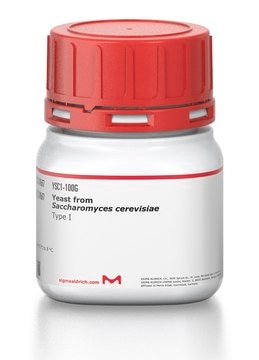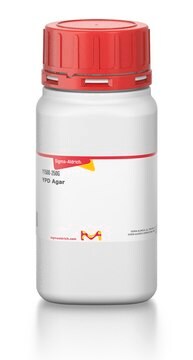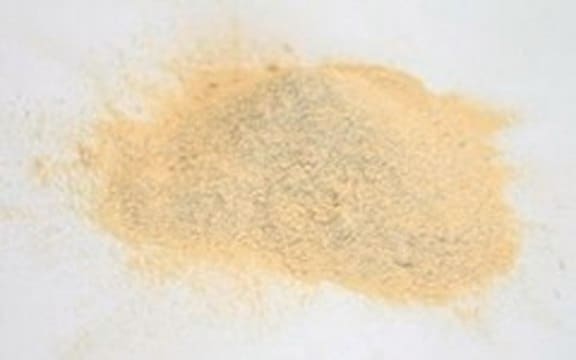YSC2
Yeast from Saccharomyces cerevisiae
Type II
Synonim(y):
(Bakers yeast)
Zaloguj sięWyświetlanie cen organizacyjnych i kontraktowych
About This Item
Kod UNSPSC:
12352202
Polecane produkty
pochodzenie biologiczne
Saccharomyces cerevisiae
Poziom jakości
typ
Type II
Formularz
powder or solid
Zastosowanie
food and beverages
microbiology
temp. przechowywania
2-8°C
Zastosowanie
Yeast from Saccharomyces cerevisiae has been used:
- in yeast sample preparation for tube-gel electrophoresis (TGE) fractionation
- as a diet supplement to study its effect on the utilization of food waste as a diet for grass carp
- for fermentation of miscanthus and the cellulose-rich extract samples to produce ethanol
Działania biochem./fizjol.
Saccharomyces cerevisiae is a unicellular fungus. Yeast from S. cerevisiae is the widely used yeast species in bread and sourdoughs. It is used to produce several fermented beverages (cider, beer, 85s, and wine) and distilled beverages (brandy, sake, vodka, and whisky). S. cerevisiae has better tolerance for fermentation stresses than any other yeast species. Hence, it is a preferred starter culture for industrial fermentation.
Przestroga
Only approx. 10% will autolyze in aqueous buffer at 37 °C.
Uwaga dotycząca przygotowania
Fast dried to yield 90% active, viable yeast in a convenient solid form.
Ta strona może zawierać tekst przetłumaczony maszynowo.
Kod klasy składowania
11 - Combustible Solids
Klasa zagrożenia wodnego (WGK)
WGK 3
Temperatura zapłonu (°F)
Not applicable
Temperatura zapłonu (°C)
Not applicable
Środki ochrony indywidualnej
Eyeshields, Gloves, type N95 (US)
Wybierz jedną z najnowszych wersji:
Masz już ten produkt?
Dokumenty związane z niedawno zakupionymi produktami zostały zamieszczone w Bibliotece dokumentów.
Klienci oglądali również te produkty
Sivasamy Sethupathy et al.
Frontiers in microbiology, 11, 584812-584812 (2020-11-17)
Indole and its derivatives have been shown to interfere with the quorum sensing (QS) systems of a wide range of bacterial pathogens. While indole has been previously shown to inhibit QS in Serratia marcescens, the effects of various indole derivatives
Margaret Clarke et al.
PloS one, 5(1), e8585-e8585 (2010-01-07)
The vacuolar H+-ATPase, or V-ATPase, is a highly-conserved multi-subunit enzyme that transports protons across membranes at the expense of ATP. The resulting proton gradient serves many essential functions, among them energizing transport of small molecules such as neurotransmitters, and acidifying
Lacrimioara Senila et al.
Molecules (Basel, Switzerland), 25(11) (2020-06-07)
In this paper, the production of a second-generation bioethanol from lignocellulosic vineyard cutting wastes was investigated in order to define the optimal operating conditions of the autohydrolysis pretreatment, chlorite delignification and simultaneous saccharification and fermentation (SSF). The autohydrolysis of vine-shoot
Eric J Kalivoda et al.
PloS one, 8(7), e71267-e71267 (2013-08-08)
Biofilm-related infections are a major contributor to human disease, and the capacity for surface attachment and biofilm formation are key attributes for the pathogenesis of microbes. Serratia marcescens type I fimbriae-dependent biofilms are coordinated by the adenylate cyclase, CyaA, and
Pretreatment of miscanthus using 1, 3-dimethyl-imidazolium methyl phosphonate (DMIMMPh) ionic liquid for glucose recovery and ethanol production
Hassan El-Sayed RE, et al.
Royal Society of Chemistry Advances, 5(75), 61455-61464 (2015)
Nasz zespół naukowców ma doświadczenie we wszystkich obszarach badań, w tym w naukach przyrodniczych, materiałoznawstwie, syntezie chemicznej, chromatografii, analityce i wielu innych dziedzinach.
Skontaktuj się z zespołem ds. pomocy technicznej





